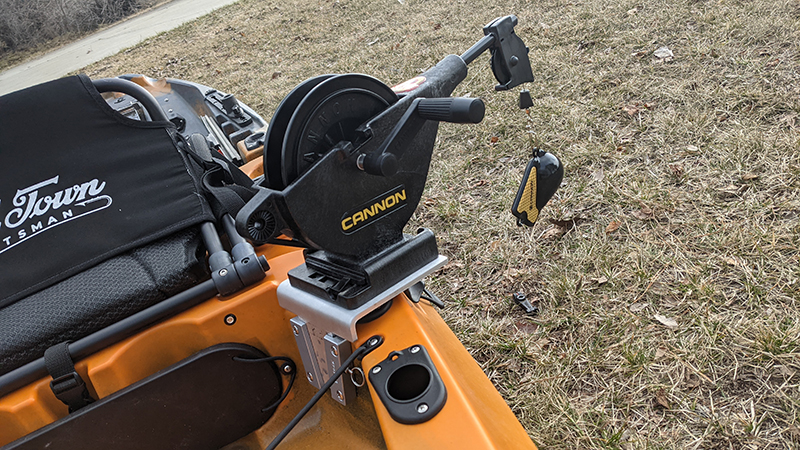Installing Downriggers on a Kayak
WHAT IS A DOWNRIGGER AND WHY WOULD I NEED ONE?
Downriggers are an important tool in many fisheries across the world. They are primarily used to target fish at precise depths while trolling and are very popular in salmon, trout, and walleye fisheries. While downrigger designs vary widely they are all built around large spools with wire cable or strong braid that attach to arms that hang over the side of the kayak. Attached to the end of the line or cable is a large lead weight varying from 4 to 15 lbs, although most kayak anglers tend to use 4 or 6 lb weights. Attached to the weight is a clip that you attach your fishing line and lure to. The weight is lowered to specific depths and when a fish strikes it releases your line and lure from the clip and you fight the fish. In this way you can target fish at extreme or even shallow depths with precision without the need for heavy lead weights on your line.
MOUNTING A DOWNRIGGER ON A KAYAK
Determining where and how to mount a downrigger on a kayak can be challenging and stressful. Before deciding where to mount it, spend some time in your kayak and get comfortable fishing and landing fish from it. You do not want your downrigger to be in the way of your normal fishing movements or, if in a PDL driven kayak, you do not want it to impede your ability to pedal. I do not recommend installing downriggers on paddle kayaks as managing deployment of the downrigger and rod while paddling would be challenging. However, pedal and electric motor propelled kayaks such as the Sportsman PDL 106 and PDL 120, and the AutoPilot kayaks all of which have a high degree of initial stability are ideal for downriggers.
Mounting locations for downriggers have two fundamental requirements. First, they need to be easily reachable from your seat. Most kayak anglers are going to opt to install compact manually cranked downriggers rather than large heavy electric powered ones. Cannon manufacturers small downriggers with both horizontally oriented handles and spools, such as on the Mini-troll, and vertically oriented spools and handles such as the Lake-troll. Determine which works best for you and your kayak. Consider installing a V-Lock mount with a backing plate for a secure and accessible mounting solution for your downrigger (pictured below).

MODIFYING YOUR DOWNRIGGER FOR KAYAK FISHING
Downriggers were not built with kayak anglers in mind. To this end I highly recommend making some basic modifications to your downrigger to make it easier to use for the kayak angler. After deciding on your installation location, cut down the length of the downrigger arm so that the downrigger line is within 12" of the hull of the kayak. This has several benefits. First this will reduce the amount of strain the downrigger puts on the hull of your kayak by decreasing leverage. This also allows the kayak to track better and increases stability. Lastly, it makes it far easier for you to reach the downrigger ball and release clips.
Nearly all downriggers come with wire cable. I recommend replacing that cable with 250-300 lb spectra braid. The braid is a much smaller diameter than the wire cable and will reduce "blowback" on the cable allowing you to fish more effectively at greater depths with lighter 4 to 6 lb downrigger balls. Additionally, if you snag the downrigger ball on the bottom or were to flip your kayak and become tangled in your downrigger line it can easily be cut with a safety knife or pair of scissors. Lastly, an added benefit of braid is that it doesn't create any humming noises that wire cable can produce on occasion and can be distracting to the angler.
From there it's simply a matter of getting out on the water and finding the fish. Downriggers are best used in concert with fish finders such as the Helix series from Humminbird. Use your sonar to locate the depth at which fish are running. Use the downrigger to deploy your gear at or just above the depth at which fish are feeding. You'll need to adjust the tension on your release clips to the appropriate strength depending on the size of fish you are chasing. Once that rod tip starts to dance with a fish on, reel down and pop the rod tip to release the fish, and enjoy the fight absent any heavy lead or weights.






